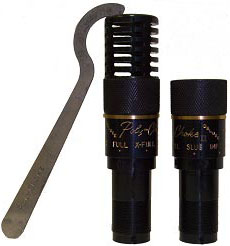|
Poly-Choke II Shotgun Choke  The Poly-Choke adjustable “one choke does it all” has been around since the 1920’s, a choke type that was one time considered high-tech, as evidenced by the many old Model 12 and A-5 shotguns out there so-equipped. The vintage Poly-Choke and the ear-splitting Lyman Cutts Compensator are two of the most prevalent adjustable choke schemes of days gone by. The new Poly-Choke II is not permanently installed; it is designed to screw into an internally threaded barrel, replacing the factory choke. It is currently available for most of the popular screw-choke guns, including most Beretta, Browning and Remington thread types. My testing was conducted with a 20 gauge Browning Silver with an “Invector-Plus” Poly-Choke II and a Beretta AL391 Urika II Gold 12 gauge with the appropriate “Optima Plus” Poly-Choke II. I hit the patterning board at 40 yards with a wide variety of lead and no-tox shot loads for each. What I found was universal disappointment with Winchester HD, Hevi-Shot Classic Doubles and Kent Tungsten-Matrix loads. While the Kent TM loads and the Winchester HD shells have been the best performers for me with factory screw-chokes and Trulock Precision Hunter Extended tubes, the Poly-Choke II did a very poor job of producing even patterns, though the point of impact was the same. The splotchy, thin patterns continued throughout the range of the adjustment. As far as the claim of the poly-choke providing a “nine barreled shotgun,” I couldn’t see that at all. It gave me a one-barreled shotgun with poor patterns. The entire test was an exercise frustration, as I spent far more than the price of the Poly-Chokes on ammunition, trying to get good patterns out of the Poly-Choke duo. With Winchester AA lead loads, the situation improved slightly. While the Poly-Choke did give increased pattern density as I increased the constriction, it could not produce pattern percentages as good as the factory “Full” chokes and the Poly-Choke patterns were very thin compared to the superb patterns thrown by the Trulock PH Extended “Full” chokes. Again, it was a time consuming and ultimately frustrating set of patterning sessions. I believe that at least part of the problem is the way the Poly-Choke II operates. The Poly-Choke has a set of "fingers" inside of it that are opened and closed by a collet arrangement. Most quality chokes today are of the “conical parallel variety,” meaning we have a tapered conical section that gives us the desired constriction or squeezing effect on the payload, followed by a straight section that is parallel with the bore, containing no taper. After the initial forcing cone area, the parallel section tends to align and stabilize the payload before it exits the muzzle. It is this parallel section, particularly an extended parallel section, which has typically given the best patterns with heavier payloads, larger shot and steel or no-tox shot. The Trulock Precision Hunter Choke is my favorite example of this. The Poly-Choke II does not do this consistently. By closing the fingers in an attempt to give more choke effect, it creates a steeper taper. After that taper, there is no parallel section, out of the muzzle flies our shot cloud. Rather than a conical-parallel type of choke system, the Poly-Choke is actually a “conical only” choke, with a conical section the same length at all times, but varying taper. I believe is it the complete lack of a parallel section that contributes to the poor performance I experienced in the course of this review. A common objection to the Poly-Choke is its aesthetically vulgar appearance, an unsightly bulb of metal larger than the outside diameter of the barrel, and the extra weight it adds to the muzzle. Although true, those were not my primary objections to the Poly-Choke II. I didn’t like it because didn’t do what I want a choke tube to do, which is produce consistent, even patterns. |